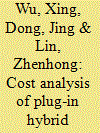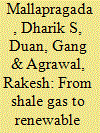|
|
|
Sort Order |
|
|
|
Items / Page
|
|
|
|
|
|
|
| Srl | Item |
| 1 |
ID:
109617


|
|
|
|
|
| Publication |
2011.
|
| Summary/Abstract |
The battery size of a Plug-in Hybrid Electric Vehicle (PHEV) is decisive for the electrical range of the vehicle and crucial for the cost-effectiveness of this particular vehicle concept. Based on the energy consumption of a conventional reference car and a PHEV, we introduce a comprehensive total cost of ownership model for the average car user in Germany for both vehicle types. The model takes into account the purchase price, fixed annual costs and variable operating costs. The amortization time of a PHEV also depends on the recharging strategy (once a day, once a night, after each trip), the battery size, and the battery costs. We find that PHEVs with a 4 kWh battery and at current lithium-ion battery prices reach the break-even point after about 6 years (5 years when using the lower night-time electricity tariffs). With higher battery capacities the amortization time becomes significantly longer. Even for the small battery size and assuming the EU-15 electricity mix, a PHEV is found to emit only around 60% of the CO2 emissions of a comparable conventional car. Thus, with the PHEV concept a cost-effective introduction of electric mobility and reduction of greenhouse gas emissions per vehicle can be reached.
|
|
|
|
|
|
|
|
|
|
|
|
|
|
|
|
| 2 |
ID:
133101


|
|
|
|
|
| Publication |
2014.
|
| Summary/Abstract |
Using spatial, longitudinal travel data of 415 vehicles over 3-18 months in the Seattle metropolitan area, this paper estimates the operating costs of plug-in hybrid electric vehicles (PHEVs) of various electric ranges (10, 20, 30, and 40 miles) for 3, 5, and 10 years of payback period, considering different charging infrastructure deployment levels and gasoline prices. Some key findings were made. (1) PHEVs could help save around 60% or 40% in energy costs, compared with conventional gasoline vehicles (CGVs) or hybrid electric vehicles (HEVs), respectively. However, for motorists whose daily vehicle miles traveled (DVMT) is significant, HEVs may be even a better choice than PHEV40s, particularly in areas that lack a public charging infrastructure. (2) The incremental battery cost of large-battery PHEVs is difficult to justify based on the incremental savings of PHEVs' operating costs unless a subsidy is offered for large-battery PHEVs. (3) When the price of gasoline increases from $4/gallon to $5/gallon, the number of drivers who benefit from a larger battery increases significantly. (4) Although quick chargers can reduce charging time, they contribute little to energy cost savings for PHEVs, as opposed to Level-II chargers.
|
|
|
|
|
|
|
|
|
|
|
|
|
|
|
|
| 3 |
ID:
122745


|
|
|
|
|
| Publication |
2013.
|
| Summary/Abstract |
Plug-in hybrid electric vehicles (PHEVs) use grid electricity as well as on-board gasoline for motive force. These multiple energy sources make prediction of PHEV energy consumption challenging and also complicate evaluation of their environmental impacts. This paper introduces a novel PHEV energy consumption modeling approach and compares it to a second approach from the literature, each using actual trip patterns from the 2009 National Household Travel Survey (NHTS). The first approach applies distance-dependent fuel efficiency and on-road electricity consumption rates based on naturalistic or real world, driving information to determine gasoline and electricity consumption. The second uses consumption rates derived in accordance with government certification testing. Both approaches are applied in the context of a location-specific case study that focuses on the state of Michigan. The two PHEV models show agreement in electricity demand due to vehicle charging, gasoline consumption, and life cycle environmental impacts for this case study. The naturalistic drive cycle approach is explored as a means of extending location-specific driving data to supplement existing PHEV impact assessments methods.
|
|
|
|
|
|
|
|
|
|
|
|
|
|
|
|
| 4 |
ID:
128380


|
|
|
|
|
| Publication |
2014.
|
| Summary/Abstract |
We present an energy roadmap for the US light duty vehicle (LDV) sector that efficiently utilizes natural gas (NG) and transitions to renewable energy and carbon sources as they become economical. We use well-to-wheels (WTW) efficiency to compare alternative NG transportation pathways. If internal combustion engine vehicles (ICEVs) remain prevalent, then compressed natural gas (CNG) is the favored fuel. Among electric powertrains, centralized electricity generation with battery electric vehicle (BEV) is more efficient than on-board generation with fuel-cell vehicles (FCV). Plug-in hybrid electric vehicles (PHEVs) balance driving range against WTW efficiency, and provide flexibility in sourcing electricity from different energy sources. Despite these efficient WTW pathways, supplying NG for the LDV sector is estimated to decrease the lifetime of current US NG reserves to about 60 years. Beyond this period, compressed methane derived from biomass can replace CNG, and utilize the would-be developed CNG infrastructure. The LDV biomass requirement depends on the biomass to methane carbon conversion and battery storage capacity of CNG PHEVs. Converting biomass to methane using solar heat/H2 leads to ~65% lower LDV biomass requirement compared to standalone processes recovering ~30% biomass carbon as methane. The resulting biomass amounts compare favorably with future US biomass supply projections.
|
|
|
|
|
|
|
|
|
|
|
|
|
|
|
|
| 5 |
ID:
112899


|
|
|
|
|
| Publication |
2012.
|
| Summary/Abstract |
In this paper, the energy consumption shares of plug-in hybrid vehicles (PHEVs) for electricity from the grid and conventional fuel depending on electric driving range are estimated. The resulting mobility costs and greenhouse gas (GHG) abatement costs per vehicle kilometer for the year 2030 are calculated and optimal electric driving range (which indicates the size of the battery) is found for different oil price levels with the help of a MATLAB based model for a typical compact passenger car (e.g. VW Golf).
The results show that the optimum electric driving range for minimum mobility costs of a PHEV is between 12 and 32 km. Furthermore, optimum GHG abatement costs are achieved with an electric driving range between 16 and 23 km. These results are considerable lower than most market ready PHEVs (electric driving range of 50 to 100 km), which shows that the automobile industry should concentrate on shorter electric driving range for PHEVs in the near future to offer cost optimum mobility and low GHG abatement costs. However, the oil price level and the consumer driving habits impact heavily on the cost performance as well as the optimum electric driving range of plug-in hybrid vehicles.
|
|
|
|
|
|
|
|
|
|
|
|
|
|
|
|
| 6 |
ID:
096095


|
|
|
|
|
| Publication |
2010.
|
| Summary/Abstract |
This study investigates plug-in hybrid electric vehicles (PHEVs) as providers of regulating power in the form of primary, secondary and tertiary frequency control. Previous studies have shown that PHEVs could generate substantial profits while providing ancillary services. This study investigates under what conditions PHEVs can generate revenues using actual market data, i.e. prices and activations of regulating power, from Sweden and Germany from four months in 2008. PHEV market participation is modelled for individual vehicles in a fleet subject to a simulated movement pattern. Costs for infrastructure and vehicle-to-grid equipment are not included in the analysis. The simulation results indicate that maximum average profits generated on the German markets are in the range 30-80 € per vehicle and month whereas the Swedish regulating power markets give no profit.
In addition, an analysis is performed to identify strengths, weaknesses, opportunities, and threats (SWOT) of PHEVs as regulating power providers. Based on the simulation results and the SWOT analysis, characteristics for an ideal regulating power market for PHEVs are presented.
|
|
|
|
|
|
|
|
|
|
|
|
|
|
|
|
| 7 |
ID:
094296


|
|
|
|
|
| Publication |
2010.
|
| Summary/Abstract |
Between 1990 and 2006, the primary energy requirement of the Irish transport sector increased by 166%. Associated greenhouse gas (GHG) emissions have followed a corresponding trajectory, and are responsible-at least in part-for Ireland's probable failure to meet its Kyoto targets. As in most countries, Ireland's transport sector is almost totally reliant on oil-a commodity for which Ireland is totally dependent on imports-and therefore vulnerable to supply and price shocks. Conversely, the efficiency and carbon intensity of the Irish electricity supply system have both improved dramatically over the same period, with significant further improvements projected over the coming decade. This paper analyses the prospects for leveraging these changes by increasing the electrification of the Irish transport sector. Specifically, the potential benefits of plug-in hybrid-electric vehicles (PHEV) are assessed, in terms of reducing primary energy requirement (PER) and CO2 emissions. It is shown that, on a per-km basis, PHEV offer the potential for reductions of 50% or more in passenger car PER and CO2 intensity. However, the time required to turn over the existing fleet means that a decade or more will be required to significantly impact PER and emissions of the PC fleet.
|
|
|
|
|
|
|
|
|
|
|
|
|
|
|
|
| 8 |
ID:
128334


|
|
|
|
|
| Publication |
2014.
|
| Summary/Abstract |
In order to reduce greenhouse gas emissions in the United States by an order of magnitude, a portfolio of mitigation strategies is needed. Currently, many utilities pursue energy efficiency programs. We study a case where utilities could choose whether to allocate their energy efficiency budget to either end-use efficiency or vehicle electrification as a means to reduce CO2 emissions. We build a decision space that displays the conditions under which utilities should pursue either strategy. To build such decision space, assumptions are needed on how consumers respond to electric vehicle incentives, and what would be the baseline vehicle selected by consumers if no incentives were in place. Since these two aspects are highly uncertain, we treat them parametrically: if consumers are replacing a conventional vehicle with a PHEV, utility incentive programs to induce PHEV adoption appear to be cost-effective for a wide range of efficiency program costs and grid emissions factors.
|
|
|
|
|
|
|
|
|
|
|
|
|
|
|
|
|
|
|
|
|